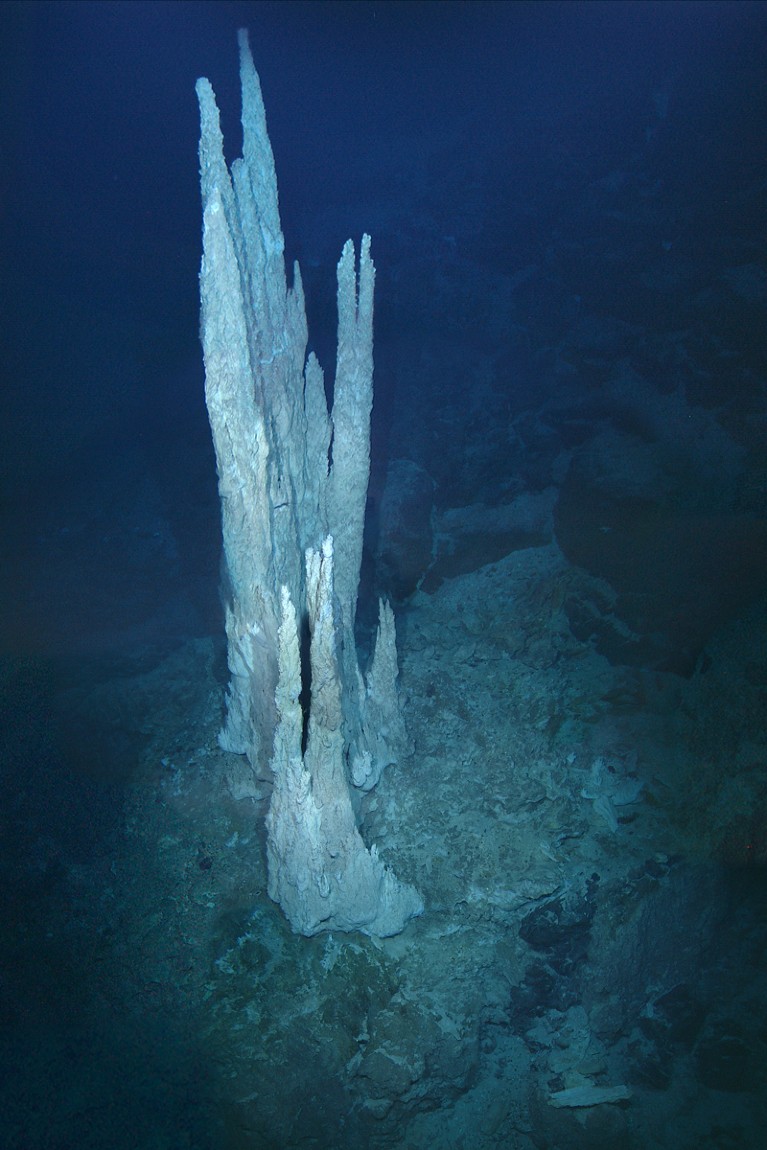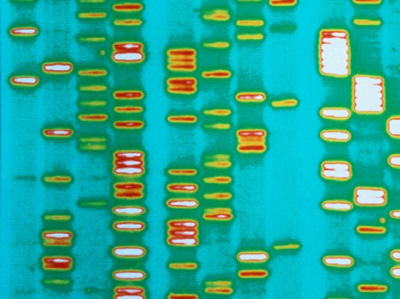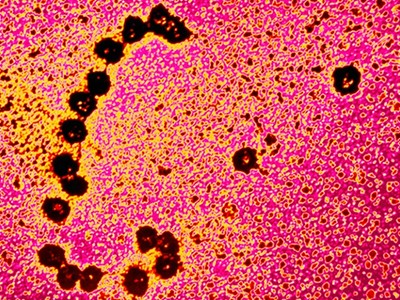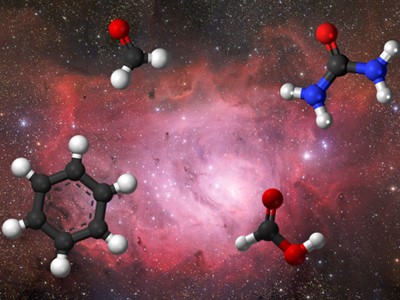
The origin of life is among the best challenges in science. It transcends standard disciplinary boundaries, but has been approached from inside these confines for generations. Not surprisingly, these traditions have emphasised completely different points of the query.
Or reasonably, questions. The origin of life is basically an prolonged continuum from the only prebiotic chemistry to the primary reproducing cells, with molecular machines encoded by genes — machines corresponding to ribosomes, the protein-building factories present in all cells. Most scientists agree that these nanomachines are a product of choice — however choice for what, the place and the way?
There isn’t a consensus about what to search for, or the place. Neither is there even settlement on whether or not all life should be carbon-based — though all identified life on Earth is. Did meteorites ship cells or natural materials from outer area? Did life begin on Earth within the sizzling waters of hydrothermal methods on land or in deep seas?
Observations alone can not constrain these potentialities. The few geological traces that trace at adolescence are enigmatic. Is a bacterium-like imprint actually a fossil, or some geochemical construction? Is a weak carbon isotope signature on the floor of a mineral a fingerprint of life (which accumulates the lighter carbon-12) or the results of one other kind of chemical exercise?
Genes should not immediately useful both. Evaluating gene sequences in fashionable organisms permits researchers to reconstruct a ‘tree of life’ going again to among the earliest cells which have genes. Though the precise genetic make-up of this ancestral inhabitants is disputed, by definition it already had genes and proteins and so can inform us little about how they arose.
How did life start? One key ingredient is coming into view
None of this precludes understanding the origin of life, but it surely does make competing hypotheses arduous to show or disprove unambiguously. Mix that with the overarching significance of the query and it’s clear why the sector is beset with over-claims and counter-claims, which in flip warp funding, consideration and recognition.
This context has splintered the sector. Strongly opposed viewpoints have coexisted for many years over primary questions such because the supply of vitality and carbon, the necessity for mild and whether or not choice acts on genes, chemical networks or cells.
To know how life might need begun, researchers should cease cherry-picking essentially the most stunning bits of information or essentially the most apparently convincing remoted steps, and discover the implications of those deep variations in context. Relying on the start line, every speculation has completely different testable predictions. For instance, if life began in a heat pond on land, the succession of steps main from prebiotic chemistry to cells with genes is surprisingly completely different from those who should be posited if the primary cells emerged in deep-sea hydrothermal vents.
Constructing coherent frameworks — by which all of the steps within the continuum match collectively — is crucial to creating actual progress. To see why, right here we spotlight two of essentially the most outstanding frameworks, which suggest radically distinct environments for the origin of life.
Prebiotic soup
Most individuals have heard of prebiotic soup. That’s partially as a result of the speculation is grounded within the chemistry that works finest for making lots of the constructing blocks of dwelling issues. Within the fashionable model of this concept, the synthesis of natural molecules begins with derivatives of cyanide, energized by ultraviolet radiation. This chemistry can produce related merchandise, such because the nucleotide constructing blocks of genes, in excessive yields — though completely different reactions happen in distinct environments, starting from laboratory equivalents of the environment to geothermal ponds and streams1.
The place did all this cyanide come from? Meteorite impacts is perhaps one supply, however there may be little settlement about that amongst geologists. Nor does this strategy clarify simply how these “reservoirs of fabric … come to life when circumstances change”2. That’s, how compounds that fashioned beneath disparate circumstances may persist for lengthy durations (doubtlessly tens of millions of years) earlier than someway coming collectively and self-assembling into rising cells.
It’s time to confess that genes should not the blueprint for all times
This framework posits that nucleotides are concentrated in a small pond. To kind RNA, the only and most versatile genetic materials, nucleotides should polymerize. That’s most simply achieved by drying them out (polymerization is a sort of dehydration response). Proponents think about a succession of moist–dry cycles, by which the pond dries out to kind polymers of RNA, then fills once more with water containing extra nucleotides and so forth, cycle after cycle, making increasingly more RNA3.
However this idea raises some troublesome questions. It locations the onus on an ‘RNA world’, by which RNA acts each as a catalyst (in an analogous approach to enzymes) and as a genetic template that may be copied. The issues are that there’s little proof that RNA can catalyse lots of the reactions attributed to it (corresponding to these required for metabolism); and copying ‘bare’ RNA (that’s not enclosed in compartments corresponding to cells) favours the RNA strands that replicate the quickest. Removed from constructing complexity, these are likely to get smaller and less complicated over time. Worse, by usually drying all the things out, moist–dry cycles preserve forming random groupings of RNA (in impact, randomized genomes). The very best mixtures, which occur to encode a number of helpful catalysts, are instantly misplaced once more by re-randomization within the subsequent technology, precluding the ‘vertical inheritance’ that’s wanted for evolution to construct novelty.
If choice on RNA in drying ponds may someway be made to generate higher complexity, what should it obtain? To make cells that develop and reproduce, RNA should encode metabolism: the community of a whole bunch of reactions that retains all cells alive. Trendy-day metabolic reactions bear no resemblance to the cyanide chemistry that makes nucleotides on this mannequin. Evolution would subsequently want to switch every step in metabolism, and there’s no proof that such a wholesale substitute is feasible.
Not like evolving an eye fixed, a course of by which intermediates have perform, encoding solely half the steps of a metabolic pathway (or half the pathways wanted for a free-living cell) has little, if any, profit. Can genes that encode a number of metabolic pathways have arisen directly? The chances towards this are so nice that the astrophysicist Fred Hoyle as soon as in contrast it to a twister blowing by way of a junkyard and assembling a jumbo jet. It isn’t ok to counter that evolution will discover a means: an actual clarification must specify how.
On stability, we might say that prebiotic chemistry beginning with cyanide can produce the constructing blocks of life, however a lot of the downstream steps predicted by this framework stay problematic.
Hydrothermal methods
Our personal favoured situation is that the chemistry of life displays the circumstances beneath which life started, in deep-sea hydrothermal methods on the early Earth4. In broad brush strokes, which means that gases corresponding to carbon dioxide (the near-universal supply of carbon in cells right this moment) and hydrogen feed a community of reactions with a topology resembling metabolism. Genes and proteins come up inside this spontaneous protometabolism and promote the flux of supplies by way of the community, resulting in cell development and copy. There are many issues right here, too, however they differ from these within the prebiotic soup framework.
Origin of life idea involving RNA–protein hybrid will get new help
The primary downside is that H2 and CO2 should not notably reactive — certainly, their chemistry was largely ignored for many years, though rising curiosity in inexperienced chemistry is altering that. However deep-sea vents are labyrinths of interconnected pores, which have a topology resembling cells — acidic exterior and alkaline inside. The circulate of protons from the surface to the within of those pores can drive work in a lot the identical means that the inward circulate of protons can drive CO2 fixation in cells right this moment5. Analysis previously few years exhibits that these circumstances can drive the synthesis of carboxylic acids6 and long-chain fatty acids7, which might self-assemble into cell-like constructions bounded by lipid bilayer membranes5.
However many chemists are troubled by the concept that, within the absence of enzymes to function catalysts, hydrothermal circulate may drive scores of reactions by way of a community that prefigures metabolism, from CO2 proper as much as nucleotides. The chemist Leslie Orgel as soon as dismissed this situation as an “attraction to magic”. Definitely, additional knowledge are required, supporting or in any other case. A number of steps have now been proven to happen spontaneously in core metabolic pathways (such because the Krebs cycle and amino-acid biosynthesis) with out being pushed by enzymes8, however that is nonetheless removed from demonstrating flux by way of the complete community.
Polymerization is one other stumbling block. Nucleotides have been polymerized in water on mineral surfaces9, however this raises comparable inquiries to these famous for moist–dry cycles about how choice may act. If the issue is solved by polymerizing nucleotides inside rising protocells, mineral surfaces wouldn’t have been obtainable. Polymerization would then have wanted to occur in cell-like (aqueous gel) circumstances, however with out enzymes. If critical makes an attempt to synthesize RNA beneath these circumstances fail, the general framework would should be modified.

A 13-metre-tall carbonate chimney within the Misplaced Metropolis hydrothermal discipline within the Atlantic Ocean.Credit score: Deborah Kelley and Mitch Elend, College of Washington
Conversely, if these troublesome issues are resolved, then the hydrothermal situation presents a promising path to the emergence of genetic data, overcoming Hoyle’s jumbo-jet argument. Patterns within the genetic code counsel direct bodily interactions between amino acids and the nucleotides that encode them, particularly for these fashioned most simply by metabolism5. Such associations imply that random RNA sequences may act as templates for non-random peptides which have a perform in rising protocells. The primary genes wouldn’t have needed to encode metabolism, however simply improve flux by way of a spontaneous protometabolism — for instance, by enabling the response between H2 and CO2.
Thus, in brief, the 2 frameworks have completely different benefits and downsides, and it’s untimely to dismiss both.
Findings may be true however irrelevant
Equally probing questions apply to different origins-of-life situations. If natural molecules had been delivered from area — for example, in carbonaceous chondrites such because the Murchison meteorite10 — then how and the place did they arrive collectively, how did they polymerize, and so forth? The supply of organics from area merely shares a soup and doesn’t clear up a lot of the downstream issues — with the additional concern that such a supply methodology is unlikely to have been dependable and constant at particular areas.
If life began out as droplets often called coacervates, by which immiscible liquids separate into distinct phases that promote various kinds of chemistry, then one should ask the place all of the precursors to feed their development got here from. And the way did these phase-separated droplets morph into cells with completely different topology, by which these distinct chemistries now principally happen beneath aqueous-gel circumstances?
Prebiotic chemistry
Comparable questions may be requested about ‘eutectic freezing’ (by which rising ice crystals focus the encircling soup) and layered minerals or pores in volcanic rocks, corresponding to basalt or floating pumice, that catalyse natural synthesis.
All of those fragments of situations are ‘true’, in that there’s empirical proof supporting every snapshot second. However the truth that it’s potential to make amino acids by passing electrical discharges by way of a Jovian combination of gases, because the US chemist Stanley Miller famously did 70 years in the past, doesn’t imply that’s how life started — merely that this chemistry is feasible. Likewise, the truth that analogous chemistry can happen in hydrothermal methods, or from cyanide in terrestrial geothermal methods, or in interstellar area, doesn’t imply that each one of those environments had been required for all times to begin, simply that this chemistry is favoured beneath many circumstances. The query is all the time: what occurs subsequent?
If none of those situations is ‘incorrect’, then there may be area within the discipline to pursue a number of frameworks. Nobody must abandon their favoured positions (but). However brash claims for a breakthrough on the origin of life are unhelpful noise if they don’t come within the context of a wider framework. The issue is finally answerable provided that the entire query is taken significantly.
Search for convergence factors
An necessary characteristic of those competing frameworks is that they need to finally converge on cells with genes and proteins — on life as we all know it on Earth. This convergence presents new potentialities for collaboration, as a result of any reply will in all probability characteristic points of a couple of framework. Precisely the place these convergences happen will depend upon which hypothetical steps are disproved.
Cofactors provide a potential convergence level. They obtained their title as a result of they work along with an enzyme to catalyse a response. However from an origins-of-life perspective, the time period is deceptive as a result of cofactors often catalyse the identical response on their very own, albeit extra slowly. Many cofactors derive from nucleotides, corresponding to nicotinamide adenine dinucleotide. These would possibly show arduous to make when beginning with CO2. Might or not it’s that cofactors had been initially synthesized from cyanide, however, as soon as in circulation, tended to catalyse CO2 chemistry, now driving a lifelike protometabolism that included their very own synthesis11?
Bringing area rocks again to Earth may reply a few of life’s greatest questions
Maybe, however this concept additionally exhibits how necessary it’s to check predictions inside a particular framework first. Within the easiest situation, all of biochemistry begins from CO2 in a hydrothermal system, whereas the choice situation requires at the very least two locations and two kinds of chemistry — including as much as rather more uncertainty. Occam’s razor says that the only situation must be examined completely first. If the only chemistry is proven to not work — that’s, if it isn’t potential to synthesize cofactors from CO2 with out cofactors — then the choice may be taken significantly.
This query could possibly be approached experimentally or utilizing fashionable computational chemistry instruments, however both means, one of the simplest ways to make progress is to check the only thought to destruction first. If it may be proven to not work, then the convergence level is perhaps actual, and must be explored significantly.
In direction of a solution
The origins-of-life discipline faces the identical issues with tradition and incentives that afflict all of science — overselling concepts in the direction of publication and funding, too little frequent floor between competing teams and maybe an excessive amount of satisfaction: too sturdy an attachment to favoured situations, and too little willingness to be proved incorrect. These incentives are amplified by the problem of disproving advanced interrelated hypotheses involving completely different disciplines when there may be so little direct proof — no ‘smoking gun’ to be found.
Altering this tradition will take some work, given the political actuality of science — the relentless strain to publish, to safe funding, tenure or promotion — however it’s obligatory if the sector needs to proceed attracting college students. This requires that scientists, but additionally editors and funders, are conscious of the problems that fragmented the sector and work to beat them. We spotlight 4 priorities to start to maneuver in the appropriate path.
Practice interdisciplinary scientists. Pursuing hypotheses throughout standard disciplinary boundaries requires a brand new technology of scientists — PhD college students, postdoctoral researchers and early-career principal investigators (PIs) — with wide-ranging experience and a willingness to check particular hypotheses inside coherent wider frameworks. The sphere will clearly profit from doctoral coaching that stresses collegiality, interdisciplinarity and the rigorous, open-minded testing of competing hypotheses.
Foster good communication. To advertise such a tradition, one in all us (J.C.X.) co-founded the Origin of Life Early-career Community (OoLEN) in 2020, which has grown to greater than 200 worldwide researchers, from college students to early-career PIs. It’s run by volunteers and has no institutional ties, monetary or in any other case. Members have interaction in debates by way of common conferences (on-line or in-person), disseminate analysis and write articles collectively. There’s nonetheless no scarcity of disagreements, however that’s a part of scientific analysis and OoLEN promotes a wholesome strategy to them12.
For later-career researchers, conferences may assist to succeed in throughout divides in comparable methods. Physics conferences have offered examples. In a single, proponents of loop quantum gravity and string idea switched sides in a debate, framing good-humoured however sturdy arguments towards their very own place in a constructive type of ‘metal manning’.
Embrace open science. Accepting that particular hypotheses shall be disproved and that frameworks shall be reshaped requires the publication of destructive outcomes — too typically undervalued and unpublished. However it’s clearly necessary for the sector to know whether or not, for instance, makes an attempt to synthesize cofactors from CO2 fail — and, particularly, beneath what circumstances.
Dissemination of destructive knowledge could possibly be promoted in a number of methods. Most beneficial is a extra systematic use of open-access, community-driven information bases that will host and curate knowledge. These would assist to collate experimental circumstances, spotlight real gaps in empirical proof and allow evaluation of huge knowledge units by way of machine-learning research.
Enhance publishing practices. Researchers ought to aspire to contextualize their findings in cowl letters, papers and press releases, to present a way of how the work suits right into a wider framework. Refraining from hype might sound unrealistic however may work if researchers applied this follow of their roles as peer reviewers for papers and grants in addition to authors.
Journal editors and grant-awarding our bodies must also think about how polarized the sector is to make sure truthful evaluations. A method to enhance the peer-review course of could be to enlist extra early-career researchers, who are typically much less entrenched of their positions. Clear peer evaluation (by which nameless reviews are revealed with a paper) may additionally curb bias, as a result of it permits constructive criticism with out concealing prejudice.
It’s too quickly to intention for consensus or unity, and the query is simply too large; the sector wants constructive disunity. Embracing a number of rigorous frameworks for the origin of life, as we advocate right here, will promote objectivity, cooperation and falsifiability — good science — whereas nonetheless enabling researchers to give attention to what they care most about. With out that, science loses its sparkle and creativity, by no means extra necessary than right here. With it, the sector would possibly at some point get near a solution.




